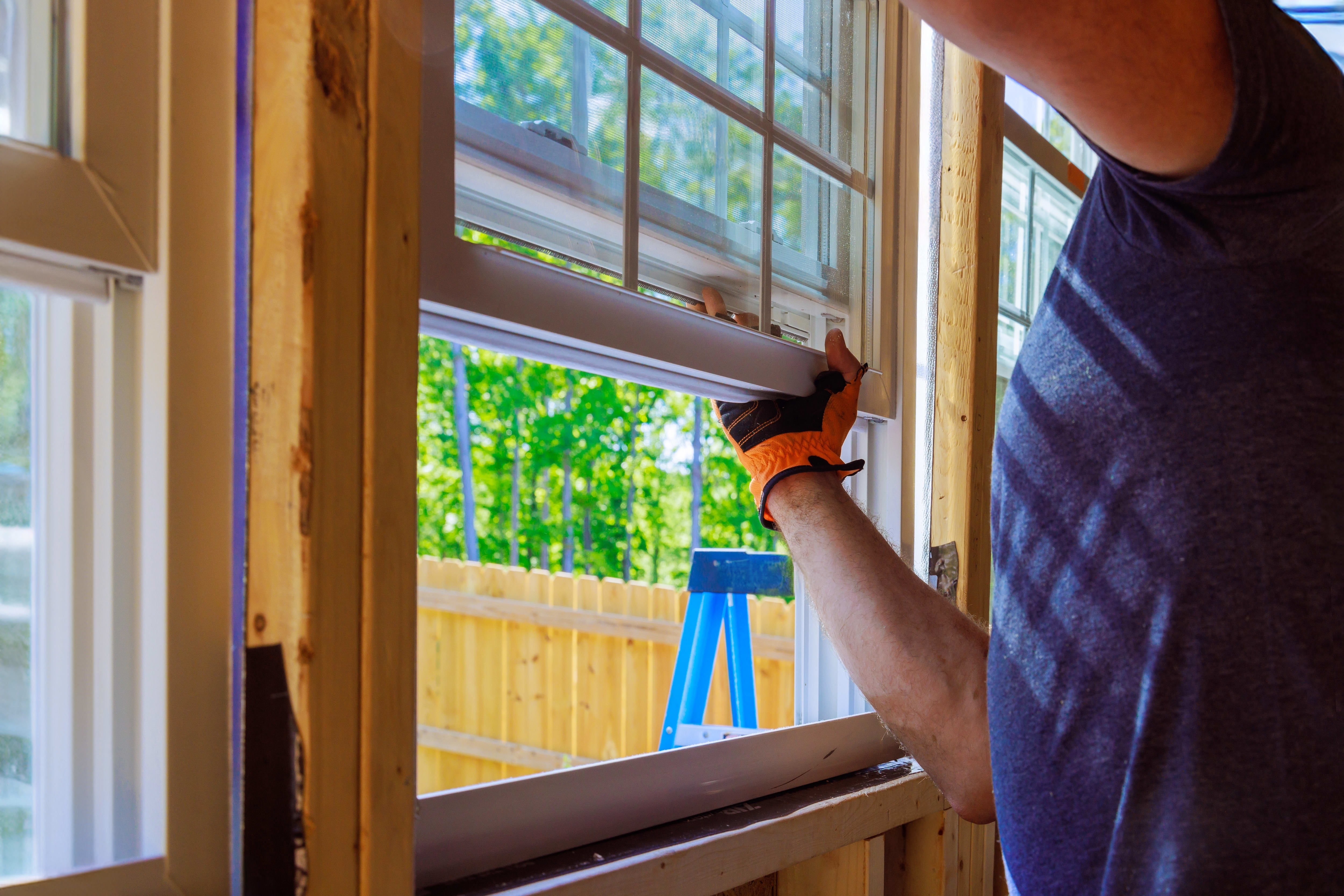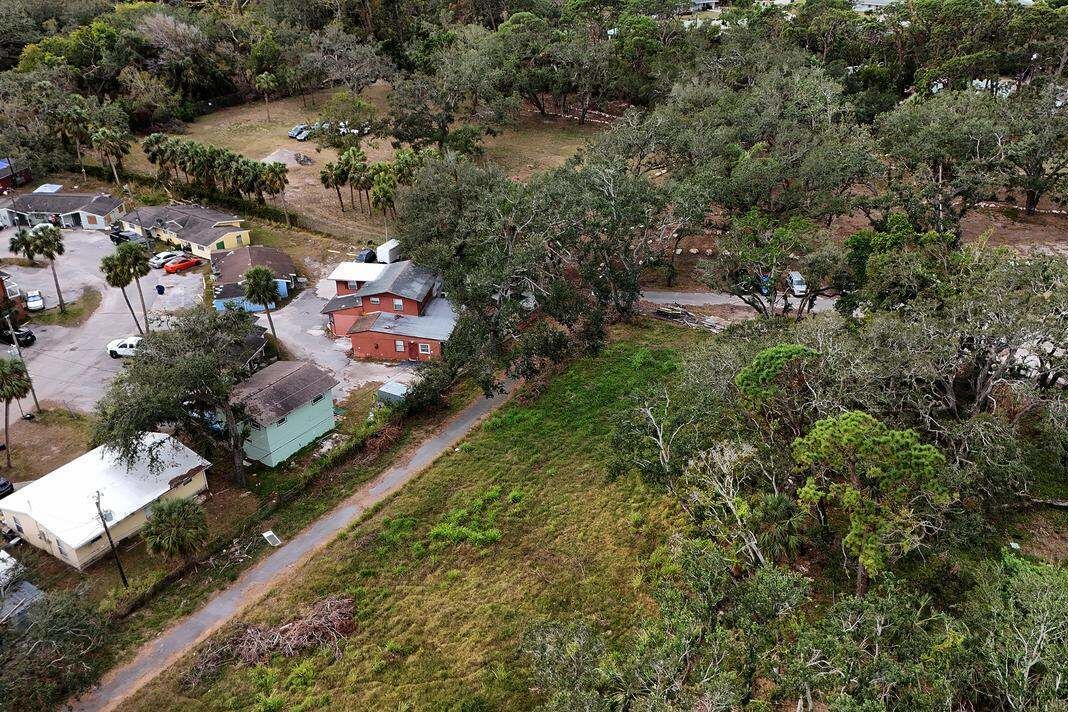Anna Maria Island's Building Boom Sparks a Civil War
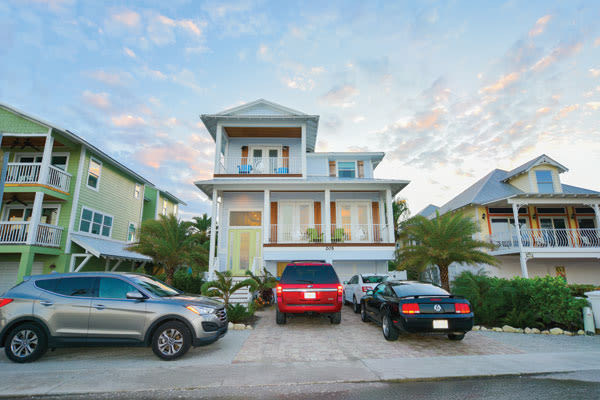
Saturday. Check-in day. Check-out day. The day when longtime residents confront everything they don’t like about the new Anna Maria Island.
Next week’s tourists arrive while last week’s depart. Sun-hungry Manatee and Sarasota mainlanders flood onto the island; day-trippers pour in from around the region. Workers arrive to clean and turn over rental units. Servers and bartenders leave home early to make it to their shifts on time. Statistics confirm what every driver crawling along the island’s clogged roads already knows—traffic spikes by 13 percent on weekends compared to weekdays. And on a holiday weekend? Forget about it. According to Florida Department of Transportation data, the number of cars on one island road jumps 28.6 percent on three-day weekends.
Visitors park bumper-to-bumper on narrow residential streets and crowd into the island’s weekly vacation rentals—new, tall, candy-colored mega-homes that tower over compact beach bungalows next door. Revelers hang out on streets and in back yards, drinking and celebrating their vacation. Their kids splash and shout. Residents call the cops, who issue warnings and citations. Things quiet down. And then the whole process repeats itself again the next week.
It hasn’t always been like this. For more than a century, charming, quiet Anna Maria Island represented escape from the hectic back-and-forth of mainland living. But in the last decade, the island has gained national recognition as one of the last bastions of unspoiled Old Florida, and tourism has skyrocketed. Traffic, noise and property values have shot up, too, leaving residents with a choice: Stay on an island that’s losing its time-honored character, or cash in on the boom and head elsewhere.
Many are doing the latter. As tourists surge onto Anna Maria Island, the number of residents is dwindling, and quite a few of those left behind say the changes are shattering neighborhoods and threatening the very charm that drew them here. The debate rages in city halls, coffee shops, burger joints and bars. At stake: nothing less than the island’s future.
Getting a precise fix on exactly how much the island’s population has declined is tough. But all the numbers point in the same direction. Down.
In March 2012, the island was home to 5,512 registered voters; by September 2015, that total had dropped to 4,809, a 12.8 percent decrease in just over three years. The number of property owners claiming homestead exemptions has also dropped, by 13.8 percent, from 2,293 in 1998 to 1,976 in 2015.

The number of children living on the island is also falling. The island’s only public school, Anna Maria Elementary, is zoned to serve both island kids and children who live on the northern half of Longboat Key. During the 2007-2008 school year, Anna Maria Elementary enrolled 209 kids from Anna Maria and Longboat. That number currently stands at 172. And during that same span, the number of kids traveling to the school from the mainland has increased. In 2007-2008, 28 percent of Anna Maria Elementary kids came from mainland Manatee County; by fall 2015, that number had risen to 37 percent.
In the same span, tourist activity has shot to previously unimaginable levels. In 2014, the Manatee County tax collector’s office raked in $4.9 million in Tourist Development Taxes generated by rentals on Anna Maria Island. Back in 2007, the county collected just $1.4 million. Even when the old number is adjusted for inflation and a 2009 increase in the tax rate, Anna Maria Island still saw a 138 percent increase in bed tax revenues in just seven years. And through the first 10 months of 2015, collections in each of the island’s three cities—Anna Maria, Holmes Beach and Bradenton Beach—had already neared or exceeded revenue for all of 2014.
Anna Maria rentals have also grown in importance to Manatee County’s overall tourist economy. Last year, as of October, nearly half (48.5 percent) of all bed tax revenue in Manatee County came from Anna Maria Island. That’s up from 35.3 percent eight years ago.
The numbers tell the story. And so do memories.
Layla Copeland, 37, grew up on the island during a time when she and friends rode their bikes all over without anyone worrying about them. “Almost every other lot was an empty lot with trees in it,” Copeland says. “You could climb trees and play kickball. Now it’s just McMansion after McMansion after McMansion.”
Copeland, a clothing designer, now lives in Sarasota with her husband and 1-year-old son. She and her family often spend weekends on Anna Maria with her parents, but she rarely runs into old friends. “Most of the islanders that we grew up with, their families have all left,” she says.
What’s changed? The cost of housing. In 2003, according to Manatee County property appraiser data, the just value of all land on Anna Maria Island stood at roughly $2.2 billion. That number rose to $3.6 billion last year, a 25 percent increase after adjusting for inflation. During that same stretch, American housing prices overall actually decreased by 4.1 percent, according to data compiled by real estate research firm Zillow.
As Anna Maria property values rise, longtime islanders have realized that those charming beach bungalows they bought decades ago sit on land that’s now worth way more than what they paid. So even residents who have lived on the island for decades are cashing out, finding developers eager to pay top dollar to replace a modest family home with a bigger house or a moneymaking vacation rental. Those vacation rentals, and the noise and traffic associated with them, in turn encourage more residents to leave.
Once upon a time, Anna Maria residents considered themselves a “band of islanders,” Copeland says: “You weren’t an islander because you were wealthy. It was just a bunch of people, like my parents, who were kind of hippies, just looking for somewhere to escape to and hang out and raise their families. You don’t have families out there now, which is sad.”
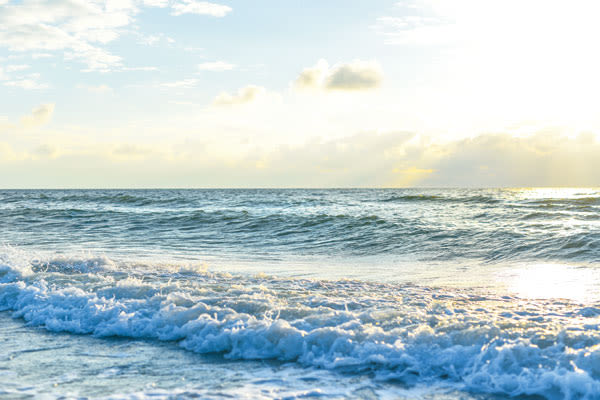
Humans have lived in the region for at least 12,000 years, but Native Americans did not occupy Anna Maria Island. Local tribes, though, did use the island for fishing, hunting and camping, leaving behind midden sites but no burial mounds.
Spanish explorers landed in the region in the 1530s, bringing disease and enslaving and executing natives. Little record of life on the island exists from then until the 1800s, when tales of shipwrecks and treasure began to circulate. The island’s first homesteader, George Emerson Bean, brought his family to a tract of land on the north end of the island in 1893. Almost immediately, the island began attracting tourists. Streets and sidewalks were laid out. A dock, bathing pavilion and hotel also went up in short order.
Over the years, settlers slowly trickled onto the island, and eventually, enough people called the island home to justify incorporation. The Town of Anna Maria was created in 1923. Already, residents were concerned about preserving their way of life. The town’s original charter empowered the new government to “regulate, restrain and prevent…offensive noises” coming from manufacturing facilities and to “suppress gambling houses, bawdy houses and disorderly houses.” (The document also gave the town the right to create segregated residential districts “for white and negro or foreign residents,” language that went unchanged until the 1970s.)
For decades, visitors traveled to Anna Maria on ferries, until the island’s first bridge was constructed, linking Bridge Street to the mainland village of Cortez in 1922. In 1926, a bridge was built to connect Anna Maria’s southern tip to Longboat Key; the island’s third and final bridge, connecting the island to Bradenton, was completed in 1957. Towns to the south of Anna Maria also sprang up. Holmes Beach, which occupies the island’s central territory, incorporated in 1950; Bradenton Beach, the island’s southernmost town, was born in 1951.
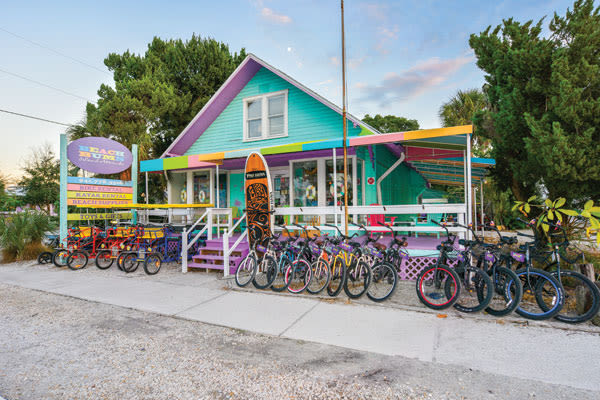
For an outsider, it can be tough to understand all the fuss about the changes that have come to Anna Maria Island. Take a drive out there and you still feel like you’re entering a different, more relaxed world.
The island runs seven miles tip to tip, with a few main, two-lane roads. Height restrictions that limit buildings to three stories have kept out towering hotels and dense condo high-rises, and many neighborhoods are still stocked with compact, one-story houses. The island has some upscale restaurants, such as the Beach Bistro, but you’re just as likely to see people flocking into coffee shops like Ginny’s & Jane E’s or burger joints like Duffy’s Tavern.
Pine Avenue, the center of Anna Maria social life in the island’s early years, was recently redeveloped, but the changes aren’t overwhelming. The town’s original jail remains standing, and the street is lined with generous wood porches, shell-covered walkways and edible native plants. The buildings range from doughnut shops to chic boutiques. Even Copeland sees the positive impact of new life on the island. “There’s a place on Pine Avenue, Pink & Navy,” she says. “It’s a cute boutique where you can get fashionable clothes on Anna Maria.” She laughs, as if the very idea of fashion on Anna Maria would have once been unthinkable. “There are positives to the growth,” she says.
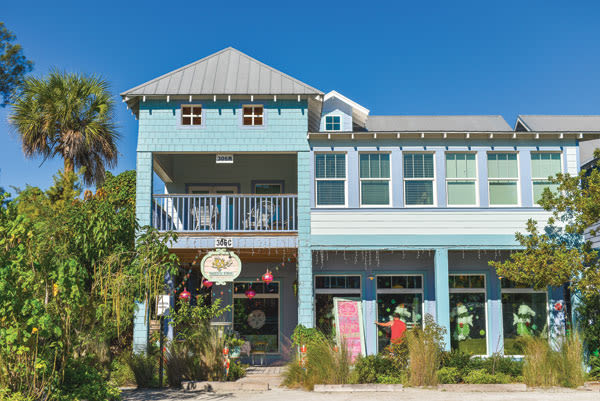
Bradenton Beach Police Chief Sam Speciale, 58, agrees. When he moved to Bradenton Beach from Chicago in the mid-’80s, the main drag, Bridge Street, was a hangout for fishermen, circus workers and bikers. “When the fishermen came back after 30 days on the boat, they had a lot of money and they went to Bridge Street,” Speciale says. “It was like the Wild West. You knew on the weekend you were going to be in a fight.”
For the most part, the violence stopped short of shootings and stabbings, but it was a tough place. Motorcycle gangs spun their tires outside bars with plywood floors. Patrons threw beers at performers if they struck an off note. “It was an amazing time to be here,” Speciale says, almost fondly.
Some Bridge Street dive bars, like the Drift In, remain, but the stretch is also now home to bistros, a jewelry shop and a putt-putt golf course. It attracts a different clientele than it did 30 years ago, and Bradenton Beach cops have adjusted the way they police the neighborhood. Businesses and property owners have invested large amounts of money in the community, Speciale says. As a result, the city cracks down on behavior it might have let fly decades ago. “When the revitalization came, [rowdy] behavior was not acceptable. Progress is progress,” he says.
“We see nothing but improvement,” says Bill Herlihy, 49, who lives in Sarasota but owns the Island Time Bar & Grill, the Island Time Inn and retail space along Bridge Street. With increased activities for tourists, visitors are staying longer, spending more money and bringing their kids. “It’s growing in a good way,” Herlihy says. “Families did not go to Bridge Street because of the element it was attracting. Now, it’s fun for families. It’s safe. My businesses—the motel, the retail and the restaurant—all have gone up in business every single year.”
Few would dispute the benefits of locally owned businesses thriving. Many residents simply resent the ways that the tourist economy has penetrated into once tranquil neighborhoods. They complain about the height and footprint of new homes and vacation rentals, the weekly infusion of a new set of transient visitors, the flurry of signs advertising rentals that are stuck in neighborhood yards, the noise and the gridlock. For more than a century, people have been moving to the island to get away. Now the world is coming to them.

On a warm fall morning, I drive out to Anna Maria to eat breakfast with Jean Peelen at Minnie’s Beach Cafe, a tiny spot tucked away in a Holmes Beach strip mall. Peelen, 74, is already there, dressed in a fuchsia cardigan, her white hair clipped close to her scalp. She tends to stare right into your eyes and speak with a disarming frankness. In 2007, Peelen left Washington, D.C., to spend a month on the island. Her younger sister had recently died and she needed a place to grieve and recover, a place where no one would look twice if she broke down in the grocery store. Six months later, back in D.C., she decided to move to the island for good.
Since being elected to the Holmes Beach City Commission in 2011, Peelen has become one of the leaders in the fight to keep vacation rentals from “destroying” neighborhoods. She’s had some victories—and setbacks. For example, she and other advocates helped convince Holmes Beach officials to create an ordinance that limited the size of new homes in some areas relative to the size of the properties on which they sit. But developers reacted by just shrinking the size of the rooms to still pack in the same number of tourists, she says.
“We thought we had dealt with it,” Peelen says. “No. We got a new surge of eight-bedroom, eight-bathroom houses.” Shortly before our breakfast, the commission banned the construction of new homes with more than four bedrooms in certain districts. “Now we think, OK, that’s going to deal with it,” Peelen says. Then she laughs. “Who knows? They’re going to come up with something. Where there’s money, there’s a solution.”
The island’s patchwork of local governments has exacerbated some of the current conflicts. Each of its three cities has attempted to design regulations to control the influx. Measures like the one in Holmes Beach have limited the percentage of a lot a new home is allowed to take up. They have also mandated larger setbacks for pools, created new parking restrictions and regulated excessive noise, but with different rules for different towns.
The Florida Legislature has also muddied the waters. In 2011, after lobbying by rental interests, lawmakers approved a bill that blocked local governments from crafting new regulations for vacation rentals. Three years later, though, the Legislature softened that, permitting local governments to regulate rentals but not “prohibit” them.
The new state rules have led to legal scuffles. Last April, the Anna Maria City Commission approved restrictions for homes that are rented out for periods shorter than 30 days more than three times a year. A month later, a coalition of island real estate companies, property owners and a real estate trade group challenged the ordinance in court, arguing that, far from an attempt to regulate rentals, the measure is really “an unworkable, arbitrary, oppressive, and cost-prohibitive scheme” whose real purpose is to “eliminate short-term vacation rentals” entirely.
“We spent close to a year working on that vacation rental ordinance,” says Anna Maria City Commissioner Doug Copeland, 69. (He is Layla Copeland’s father.) He says he’s confident the city’s rules are fair, but he understands the power of the groups challenging the ordinance. “The vacation rental industry in Florida is a huge business,” he says. “And it’s well-financed.”
Peelen knows that many believe that those complaining about the new vacation rentals are just grumpy cranks. Recently, she and others islanders have come together under the banner of Home Sweet Home, an effort to market the island as a place to live, not just visit. The idea is to counter the negativity that dominates so much discussion about the island’s future with some optimism. The group is targeting executives moving to Manatee County and trying to recruit young families to bolster civic institutions like churches and the elementary school. Dissatisfied older residents may get fed up with tourism and traffic and leave the island behind. Younger residents feel more hopeful about the island’s future.
“Everybody dates what they think about the island from the day they first crossed the bridge,” Peelen says. “The younger families crossed the bridge in the middle of this. They’re not going around saying, ‘This is horrible. Look what’s happened.’ They’re saying, ‘Here’s where we are. Now where do we go?’ It’s a whole different mindset.”
But that doesn’t mean recruiting more young families will be easy. In 2014, the average listing price for an island condo was $387,000. For a single-family home? $800,000. Those numbers come from a report put together by the Urban Land Institute, commissioned jointly by the island’s three cities and paid for by Manatee County. The report also shows that annual rentals have grown increasingly scarce. In 2000, annual renters filled 18 percent of island housing units; by 2010 that percentage had dropped to 12.
Island Real Estate owner Larry Chatt says he can’t imagine a young family making a go of it on the island without a household income of at least $250,000. Census Bureau data shows that nationwide, in the 35-44 age bracket, prime young family territory, the median household income is just $66,693.
That economic reality is helping to cause more traffic. Working residents who can afford to live on the island typically must drive to the mainland for their jobs, since the island mainly offers low-paying service jobs. At the same time, those service workers are all driving across the same bridges to go back and forth to work.
That situation is also one reason the island is getting older. Between 2000 and 2010, the median age rose from 56 to 61 in Anna Maria, from 54 to 61 in Holmes Beach and from 50 to 59 in Bradenton Beach. For most young people, even those who have fallen in love with the island, living there is not an option.
Peelen may speak directly on most matters, but there’s one person she doesn’t name at Minnie’s: Shawn Kaleta. But it’s not hard to guess whom she’s talking about when she refers to the “one main bad actor” in the island’s development community, “a horror show” and, in an email, “the dreaded developer.”
Kaleta, 38, first came to Anna Maria 16 years ago. He was working in Cincinnati for Proctor & Gamble, but didn’t want to stay. Planning to take a year off, he drove the coast of the Carolinas and up and down Florida’s beaches. He ended up checking into an island Econo Lodge late one night. When he woke up, he walked the beach. He chatted with a local who was listing a house, then later ran into the same guy at Publix. Serendipity. Kaleta made an offer.
Since then he’s become a polarizing figure. His companies include Beach to Bay Construction, Beach to Bay Investments, AMI Beaches Real Estate and Anna Maria Vacations. He’s built close to 500 homes, and has worked on projects on Anna Maria, Longboat, Lido and Siesta, and in Sarasota, Bradenton, Tampa and St. Pete. Ask him why he receives so much heat from islanders and his answer is simple: Because he’s on top.
I meet with Kaleta in a beachfront home of his that doubles as an office. He uses the space to entertain guests and hold laid-back meetings. Outside, 40 or so plastic chairs in various shades of SweetTart sit next to a tiki bar, facing the water. Inside, the walls are lined with bright white farmhouse panels and accented with teal. Kaleta wears shorts, a T-shirt and sandals and a closely clipped beard. Sunglasses rest on top of his baseball cap.
To Kaleta, life on Anna Maria Island isn’t all that different from when he arrived in 2000. The island has always been home to retirees and tourists, he says. What’s changed is the way in which people vacation. “Families now want to travel together,” he says, “and a two-bedroom, one-bath is no longer sufficient.”
Kaleta says he’s simply building houses that are in line with what today’s consumers want. According to Census Bureau numbers, he’s right. Forty-six percent of new single-family homes built in America in 2014 included four or more bedrooms. That’s up from 23 percent in 1973. The average square footage of a single-family home increased from 1,660 in 1973 to 2,657 in 2014. Island cities are mistaken if they think they’ll attract new residents by capping home sizes, Kaleta argues.
Ever since he purchased his first home on the island, Kaleta has been buying and selling and building. Originally, locals greeted his work with open arms, he says, but things changed around the onset of the Great Recession.
Other developers crashed and burned when the housing bubble popped, but Kaleta’s companies continued to thrive. That’s when locals began pushing back.
Larry Chatt owns Island Real Estate, which manages around 275 vacation rentals. He says that over the past decade, the island has stayed one step ahead of national real estate trends. Anna Maria real estate was suffering a decline well before the bubble popped elsewhere. In late 2005, the height of the boom, sales on the island were dropping. By the time other regions started feeling the pain, Anna Maria’s market was rebounding. Since the end of 2008, sales have risen year after year.
But the recession did affect the island’s economy. The crash made investors careful, says Chatt. Even if they were doing all right, they knew someone who had lost everything. So when they looked for properties to invest in, they wanted security. They looked for homes that would generate income. In 2005, roughly half of investors were asking Island Real Estate about potential rental revenue, Chatt says. By 2010, 80 to 90 percent of investors who walked in the door planned to put their homes on the rental market.
Since then, island real estate companies have each added at least 30 percent more vacation rentals, Chatt estimates.
That shift has led to some of the backlash from local voters and to city governments that have created “utter chaos” by “trying to limit and restrict everything,” Kaleta says.
In his view, complaints about noise are vastly overstated. For the most part, island rentals don’t attract hard-partying college students. The Bradenton Area Convention and Visitors Bureau doesn’t collect separate statistics for beach visitors, but the average head-of-household age of a family visiting Manatee County is 49, with a median household income of $110,000. Not spring break material.
But while Kaleta is quick to point out the folly of new city regulations, he doesn’t fight them. He doesn’t attend commission meetings and rarely talks to the press. He accepts whatever rules local government cooks up, even if he disagrees with them.
“If we’ve elected these officials and that’s the decision they make, I’m going to stand by it. I’ve never done something that’s against what the rules state, despite what people may believe or say,” Kaleta says. “They’re not going to give me a permit if it doesn’t meet code. Every permit we pull meets code, by law.”
Kaleta is also not opposed to all government intervention. Build a parking lot on the mainland, limit renters to two cars and let visitors scoot around on golf carts, he suggests. That would ease traffic. And hire a professional urban planner to develop a vision for all three cities that includes smart development patterns and good transportation networks.
“We need to not be so stubborn and set in our ways,” he says. “We need to work together to come up with a way that this island can grow.” As long as the sand remains on the beaches, he says, tourists will come. “Everybody gets here and they’re like, ‘Well, we don’t want anybody else here,’” Kaleta says. “You know what? I welcome, I want everybody to come here.”
After our conversation, Kaleta walks me outside to my car. A Holmes Beach Code Enforcement truck is idling in the sandy driveway, and an officer in a red Code Enforcement polo shirt, with a badge clipped to his belt, is waiting for Kaleta. They know each other well. A neighbor has called to complain about Kaleta leaving his garbage cans on the side of the road rather than behind the small wall that runs along the edge of the property, where the trash cans belong. Kaleta guesses immediately who called in the complaint. The same neighbor phones Code Enforcement about him regularly. Kaleta shakes his head, but he’s not surprised.
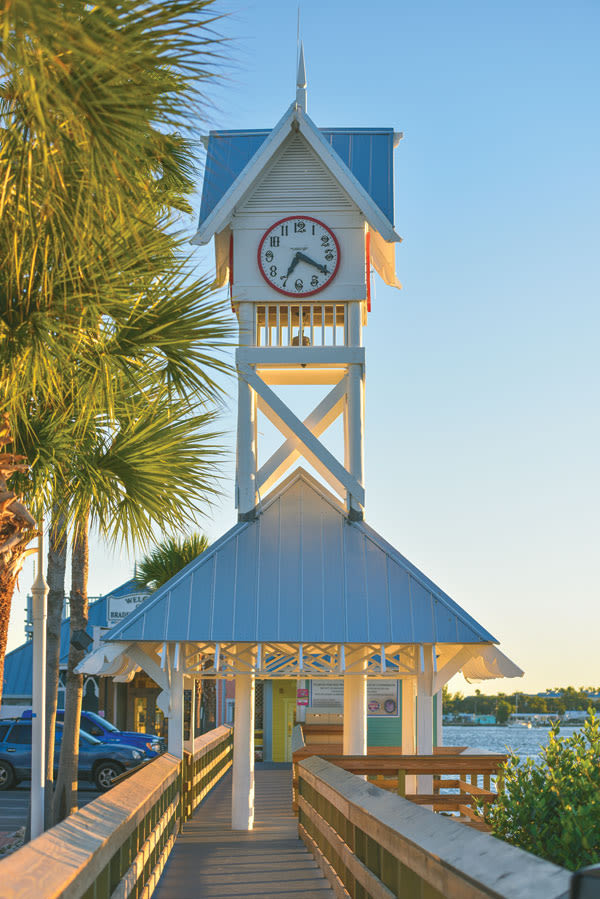
Home Sweet Home, the coalition of island residents committed to convincing people to move full-time to Anna Maria Island, held an all-island meeting last October for all those interested in the group and its mission. One hundred and five residents turned out; 30 volunteered to join a committee. A month later, those volunteers are gathering on a Wednesday evening at Bradenton Beach’s Annie Silver Community Center. A white concrete building with a tall, wooden A-frame roof, the center is named for the woman who donated the property to build it. In 1922, Silver became the first private citizen to drive across the bridge that first connected the island to the mainland. She bought land in Bradenton Beach in the 1930s and operated a grocery store and real estate company.
Peelen is here, of course, as is Bradenton Beach Mayor Bill Shearon, fresh off winning a 195-195 electoral tiebreaker by drawing an ace of clubs, besting his opponent’s 10. As friends chat and catch up, volunteers write down their names and contact information and break everyone into three groups. One is charged with brainstorming social media ideas, another with developing connections between activists and local companies and organizations, and the third with figuring out creative ways to promote living on the island.
Tonight, there’s little kvetching about the problems the island faces. The group is focused on getting results. Jerry Murphy works with the University of Florida’s Florida Resilient Communities Initiative. The gathering represents a positive next step, he says, a moment of “planetary alignment” between the cities in which real action might take place.
The volunteers face a mathematical challenge. More and more people want to come here. But the island is, after all, an island. There’s no more land. And builders can’t go any higher. Market logic says prices will only rise, and the island will grow only more exclusive.
Still, other islands have figured out a balance. When a bridge was built in 1963 to connect Sanibel Island to the mainland, residents fretted that new growth would spoil the island’s natural beauty. They voted to incorporate in 1974 and two years later approved a proactive comprehensive plan that pushed development away from sensitive areas and created a network of paths, sidewalks and boardwalks that limited the need for automobiles.
At the Annie Silver center’s long white tables, people debate different ideas. How about creating a land trust that buys up open space and old homes? Maybe volunteers could work with local realtors to greet new buyers and make sure they feel welcome. Perhaps someone could develop a plan for workforce housing.
The mood remains upbeat, convivial. Subcommittee leaders hammer out plans for to meet again soon.
Kelly and Mike Smith are one of those young families the volunteers consider so important. Kelly, 34, moved to the island with her husband, Mike, also 34, and their three children a few years ago. A Naples native, Kelly spent childhood summers on Anna Maria and she and her husband got married there a decade ago. Four years ago, they were living in Atlanta, but weren’t sure why. Kelly was working as a nurse, while Mike works remotely in health care sales and with startups. They could have moved anywhere; they chose the island.
Contrary to perceptions, she says, there is a tight-knit community of young families on the island. Some parents work remotely; others travel for work and use the island as home base; some are stay-at-home parents.
Anna Maria looks different from when Kelly visited as a kid, but not all that much has changed, she says. The island is like someone who’s had plastic surgery. The houses are bigger and showier, but its personality is much the same—kind, supportive and safe. True, day-trippers leave trash behind and in-season traffic can be a mess. “[But] when you drive over the bridge, it’s worth it,” Kelly says.
Copeland, the Anna Maria city commissioner, has lived on the island for four decades. Vacation rentals have taken over some of the homes near his, but he says they’ve never been the nuisance that he hears others can be. I ask him if he’d ever consider cashing out and moving away. “No, never,” he says. “Yeah, Anna Maria’s not like it was in ’61 or ’71 or ’81 or ’91, but it’s still a damn good place to live.”

